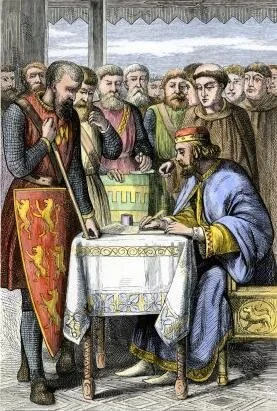Demystifying the Peerage

Derived from the Latin pares — or equal — (because the chief vassals of early Anglo-Norman kings regarded each other as equals), dukes, marquesses, earls, viscounts, and barons are referred to collectively as "the peerage." Many European titles of nobility, including those used in Britain, originated during the Holy Roman Empire of the 9th and 10th centuries. Some were derived from Roman titles of rank, while others were distinctly Germanic in nature. Such titles were frequently linked to specific lands, powers, and responsibilities. For instance, English and Scottish (but not Irish) peers had the right of summons to parliament. British hereditary titles typically passed from father to son. In the absence of a suitable male heir titles would then pass from older brother to younger brother, or from husband to wife, or from father to an eldest daughter, as when a reigning father or brother died without a suitable male heir (e.g., Queen Elizabeth II of England). As for how many people the peerage consisted of at any given time or place, during the reign of Elizabeth I (1558–1603), Britain had one duke (whom the queen had executed in 1572), one or two marquesses, some 20 earls, two viscounts, and about 40 barons, all out of a total English population of 3 to 4 million.
Prince/Princess: A child of the English monarch is referred to as a prince or princess. Although not titular members of the peerage, princes are often raised to dukedoms or granted such a place in the highest level of the peerage by their reigning parent (e.g., the eldest son of the monarch of England becomes Duke of Cornwall either at birth or when his parent assumes the throne). Regional princes sometimes ruled independently of the monarchy, as was the case in Wales until 1282, when the Welsh Prince Llywelyn was slain in battle by the English soldiers of Edward I. Since that time, the English crown has reserved the right to confer the title of Prince of Wales, as Elizabeth II did for her son Charles in 1958. The wife of a prince is a princess, as is a woman who holds the title by virtue of birth to a monarch. Whereas the wife of an English king is his queen, the husband of a reigning queen of England holds the title of "prince" or "prince consort" (e.g., Prince Philip, husband of Queen Elizabeth II).
Earl (or Count)/Countess: Introduced during the reign of the Danish King Canute in the early 11th century, this oldest title in the peerage was originally held by a royal officer in charge of a shire. Derived from the Danish jarl, or "chieftain," it was anglicized first to eorl and thence to earl. The continental equivalent is the count.
Viscount/Viscountess: Meaning the lieutenant or deputy of a count, the title of vice-count was probably created during the Holy Roman Empire, prior to the reign of Frederick I Barbarossa, and was carried to Britain during the Norman Conquest. It is the fourth level of the peerage and the latest to be introduced to England (the first viscount was titled in 1440). Viscount is also used as a title of courtesy for the eldest son ofan earl or marquess.
Baron/Baroness: Barons derived from the land they held, called a barony, are the lowest level of noble entitled to sit in the House of Lords, and are granted land directly from a sovereign. Historically, the baronage relished the power they lorded over those below them but chafed at royal control. It was the barons of England who took advantage of the weakness of King John "Lackland" by foisting the Magna Carta upon him.
Baronet/Lady: Baronets were originally English barons who had lost the right of individual summons to Parliament. In 1611, King James I created a hereditary order of baronets and sold the title to gentlemen willing to set up plantations in Ireland. Thirteen years later, baronetcies were also created for gentlemen prepared to settle in Nova Scotia. (Only one woman, Mary Bolles, was ever made a baronetess.) The title for the wife of a baronet was simply "lady."